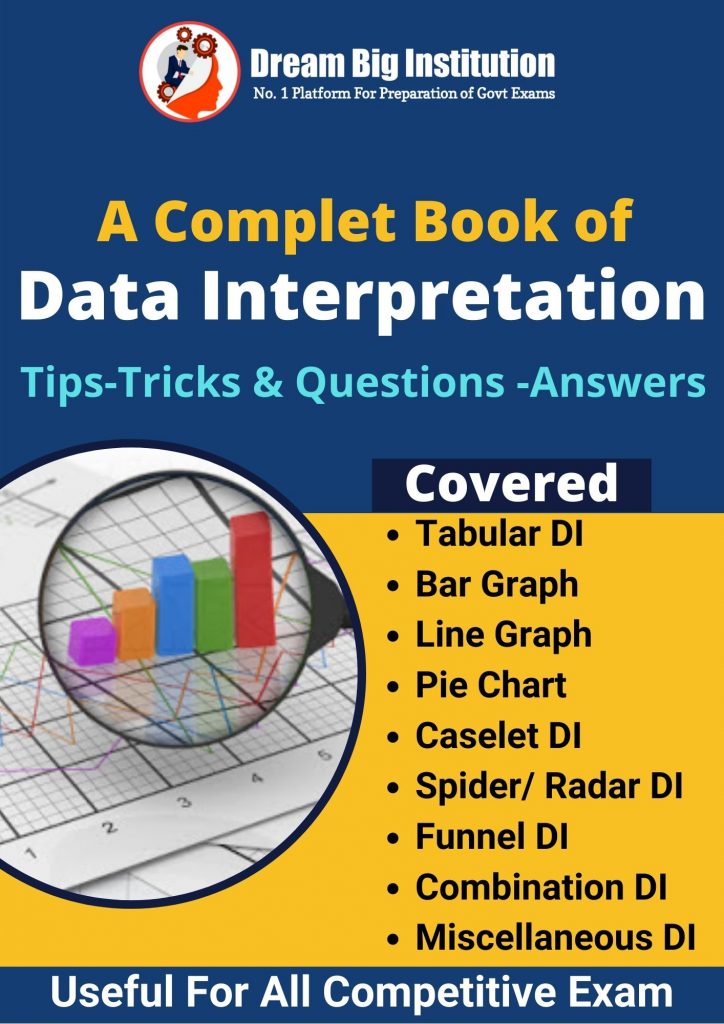Table of Contents
Data Interpretation Questions PDF for the 2023 Exam
Hello Dear Aspirants,
Data Interpretation PDF Questions here, is one of the highly coveted sections in the Quantitative Aptitude Section. It is common for both the Preliminary Exam and Mains Exam. The difficulty level of the questions though varies for both phases. So use Data Interpretation “Score-Up PDF” with a solution for practice.
With the upcoming Competitive exams like Banking, SSC, Railway, and other Exams, you must be looking for practice questions to score well. Here in this article, we have given Data Interpretation PDF for SBI PO practice questions for Upcoming Exams 2023. These contain different types of data interpretation Pdf questions ranging from Easy to High Level. Candidates are advised to practice them thoroughly to ensure selection in the upcoming Competitive Exams.
Data Interpretation Questions PDF (Overview)
| Description | Details |
| Article Name | Data Interpretation PDF |
| Category | Study Material |
| Covers | Quantitative Aptitude DI PDF (All Type Cover) |
| Total Questions | 1000+ |
| Useful For | Bank| Insurance| SSC| Railway & other Competitive Exams |
| Language | English |
| Format | |
| Quality | Best |
| Compiled By | Dream Big Institution Team |
Data Interpretation PDF Questions & Answers
Dream Big Institution Team has started a New Initiative Data Interpretation Score-Up PDF which consists of 1000 Practice Questions with detailed solutions. Aspirants who are preparing for upcoming Bank, SSC, Insurance, and Railway exams should practice high-level DI. So Downloading the Data Interpretation PDF for the 2023 exams makes use of it. Kindly share this with all your friends.
Data Interpretation Score-Up PDF for Banking Exams
| Tabular Data Interpretation Score-Up PDF Useful For SBI Clerk Exam | Download PDF |
| Data Interpretation Score-Up PDF Useful For Bank Mains Exam | Download PDF |
| Data Interpretation Questions & Answers For SBI PO Exam | Download PDF |
| Line graph Data Interpretation for SBI & IBPS Exam | Download PDF |
| Funnel Data Interpretation Questions PDF | Download PDF |
Data Interpretation for SSC Exams
| Data Interpretation Questions & Answers PDF in Hindi for SSC Exam | Download PDF |
Importance of DI PDF:
Data interpretation is an important topic for aspirants preparing for various competitive exams. There are various types of DI such as line graph, bar graph, pie chart, radar graph. Caselet DI, etc.
- Here you can practice data interpretation PDF from basic to complex questions. So that you can master all the Types of DI.
- DI practice will improve your calculation skills. You can pick up speed in math calculations.
- If you are good at DI, then you can overtake many competitors in the exam easily.
- You can practice exam point of view DI questions here, especially with data interpretation pdf for SBI clerk / PO 2021.
Types of Data Interpretation
There are several different types of data interpretation, each of which presents data in a different format and requires different skills to analyze and interpret. Some common types of data interpretation include:
- Table interpretation: This type of data interpretation involves analyzing data presented in a table format, such as a spreadsheet. Test-takers may be asked to calculate percentages, ratios, or other statistics based on the data in the table.
- Graph interpretation: This type of data interpretation involves analyzing data presented in a graphical format, such as a bar graph, line graph, or pie chart. Test-takers may be asked to calculate percentages, ratios, or other statistics based on the data in the graph, or to make inferences or predictions from the information presented.
- Caselet: This type of data interpretation involves reading and understanding a short passage that describes a situation or scenario and then answering questions based on the information presented in the passage.
- Bar Graph: Bar Graphs are used to compare two or more quantities. There are mainly two types of bar graphs, vertical and horizontal. The vertical bar graph is also called as Column graph and the horizontal bar graph is known as a Bar graph.
- Line Graph: Line Graphs are used to show the continuous change of a variable with respect to another variable.
- Pie Chart: Pie charts are circular charts which is divided into sectors that illustrate numerical proportion. In a pie chart, the arc length of each sector is proportional to the quantity it represents.
- Pictorial representation: This type of data interpretation involves analyzing data presented in a pictorial format, such as a flowchart, map or diagram.
In general, the key to interpreting data effectively is to understand the context in which the data is presented and to be able to identify patterns and trends within the data. It also requires good mathematical and analytical skills, as well as the ability to think critically and make logical deductions based on the information presented.
Basic Tips for solving Data Interpretation Questions
- Understand the question: Before you begin analyzing the data, make sure you understand the question being asked. Read the question carefully and make sure you know what information you need to find in the data.
- Analyze the data: Look at the data carefully and try to identify patterns and trends. Look for key numbers or data points that will help you answer the question.
- Make calculations: If the question requires you to make calculations, such as finding percentages or ratios, make sure you are using the correct formula and that your calculations are accurate.
- Use visualization: Try to visualize the data in your mind. This can help you understand the data better and identify patterns or trends more easily.
- Take notes: As you analyze the data, take notes on important information or calculations. This will help you to organize your thoughts and keep track of the data.
- Practice: Practice with sample questions and practice sets. This will help you to get familiar with different types of data interpretation questions and improve your problem-solving skills.
- Be aware of the context: Always keep in mind the context in which the data is presented. This will help you to understand the meaning of the data and make more accurate conclusions.
- Double-check your answers: Before submitting your answers, double-check your calculations and make sure that your answers make sense in the context of the question.
Remember that with practice, you will become more comfortable with data interpretation questions and be better equipped to tackle them under time pressure.
Tricks to solve Data Interpretation Questions
1. Visual Approximation for elimination:
You can rely on visual approximation when bar graphs and line charts are in question. For this, before you start calculating, you must try and eliminate a few options based on visual clues. Some options provided in the question can be easily ruled out by just looking at the pie chart or line graph.
Usually you are left with just close options out of which one will be the solution. So just do detailed calculation for these 2 options to save time.
2. Get acquainted with all the types of DI Questions:
Familiarize yourself with all types of DI Questions. While practicing you will realize that there are different types/formats of DI Questions. For example pie charts, line graphs, bar charts, tables and so on. If you get familiar with all types of DI questions you will gain the confidence to solve all the types of questions in IBPS PO and Clerk exam.
Questions can at times have two types of graphs in a single block.
3. Interpret the data before you begin with calculations:
You should first read and interpret the data and do not blindly start solving. Don’t miss out on any statement given in the question. Remember that banks want to hire aspirants who are adept and comfortable in handling numbers.
4. Tips to reduce calculation time
In DI most of the questions are usually based on percentage increase and decrease, ratios and averages. A simple trick for solving data interpretation problems quickly is:
- learn tables till 20.
- learn fractions till 1/20 to improve your speed
- Waste little time in finding averages:
Here if you have to find averages for sales in branches B1 to B6 for the year 2014, use this shortcut:
What you usually do: [80+75+95+85+75+70]/6
Instead: 70 + [10+5+25+15+5]/6=70+ [60/6]= 80
With this technique, you will reduce calculation time and are also bound to make less mistakes.
5. Solve questions in the order in which they appear:
It is usually seen that the answer to the first question is useful in solving the next question. So it is advisable that you solve the questions in the order in which they appear.
Also if you make mistakes while calculating the first question, you will most probably make mistakes in the subsequent questions. So be double sure of your answers.
6. Do not use calculators while Practice
You are not allowed to take the help of a calculator in the examination. So while calculating percentage increase and decrease, you should get into the habit of calculating mentally in your daily practice. Instead of finding exact values, try approximation to get to the closest answer. This will increase your speed gradually till you take the exam.
Do not use approximation too frequently in a single question if the options are too close.
7. Catch hold of the right data
You have to be careful to read data from the right spot. While gathering data from a chart, table or graph its quite easy to mistakenly copy numbers from the wrong graph, bar or line. To avoid silly mistakes while copying numbers, especially when the exam is online, point your finger to the data you want, place your finger directly opposite the question and hold it there until you are sure you are looking at the right part of the right graph. It is better to read two times and calculate one single time.
Most of the time mistakes are made in using the wrong data and not in calculations. Also keep a note of the units in the graph, question and answer. Sometimes different units are used just to confuse you. So, don’t copy hurriedly.
Data Interpretation Question asked in Previous Year Exam
Candidates must know that Data Interpretation is one of the most important topics in the Quantitative Aptitude section for All Competitive Exams and more practice will help them score more and solve them within a short period of time.
Given below a few Previous Year Questions for the reference of candidates and to help them prepare for the upcoming Competitive Examinations.
Directions: Answer the following question based on the information given below.
The table below shows the number of cases of various crimes reported at police stations in different states in 2015-16.
| State | Domestic Violance | Dowry | Rape | Molestation | Trafficking |
| UP | 354 | 496 | 263 | 132 | 342 |
| MP | 376 | 225 | 216 | 125 | 117 |
| HP | 87 | 125 | 53 | 56 | 57 |
| Kerala | 535 | 352 | 226 | 364 | 126 |
| Gujarat | 455 | 225 | 252 | 175 | 144 |
| Bihar | 475 | 576 | 675 | 764 | 852 |
| Punjab | 245 | 256 | 259 | 261 | 263 |
| Assam | 278 | 274 | 276 | 252 | 363 |
Q. How many cases have been reported from Gujarat in all?
A) 1751
B) 1331
C) 1251
D) 1221
E) None of these
Correct Option: C
Total cases reported from Gujarat = 455 + 225 + 252 + 175 + 144 = 1251
Hence, option C is correct.
Q. The Domestic violence and Dowry cases reported in Bihar are what percent more/less than the Rape and Trafficking cases reported in Punjab?
A) 98.7% less
B) 101.3% more
C) 101.3% less
D) 98.7% more
E) None of these
Correct Option: B
Domestic Violance and Dowry in Bihar = 475 + 576 = 1051
Rape and Trafficking in Punjab = 259 + 263 = 522
Difference = 1051 − 522 = 529
∴ Reqd % = 529/522 × 100 = 101.3% more
Hence, option B is correct.
Q. Based on the average number of Rape and Molestation cases reported per state, Molestation is approximately how many times as prevalent as Rape?
A) 1.04
B) 0.96
C) 0.92
D) 0.86
E) None of these
Correct Option: B
Total cases reported on Molestation = 132 + 125 + 56 + 364 + 175 + 764 + 261 + 252 = 2129
Total cases reported on Rape = 263 + 216 + 53 + 226 + 252 + 675 + 259 + 276 = 2220
∴ Required ratio = 2129 : 2220 = 0.96
Hence, option B is correct.
Q. The total number of Dowry and Molestation cases reported in UP is approximate what percent of the total cases reported in that state, across all crimes?
A) 40
B) 45
C) 37
D) 47
E) None of these
Correct Option: A
Total number of Dowry and Molestation cases reported in UP = 496 + 132 = 628
Total cases reported in UP = 628 + 354 + 263 + 342 = 1587
∴ Reqd % = 628/1587 × 100 = 39.57%
The closest value in the options is 40%.
Hence, option A is correct.
Q. In which state are the least number of cases reported?
A) UP
B) Punjab
C) MP
D) Assam
E) HP
Correct Option: E
This question can be solved very quickly by observation.
HP has the lowest reported cases for each crime. Hence, it will have the least number of cases across all crimes.
Hence, option E is correct.
FAQ on Data Interpretation Questions
Q. What are data interpretation questions?
Ans: Data interpretation questions, which often feature in numerical reasoning tests, assess someone’s ability to interpret mathematical data.
Q. What are two types of data Interpretation?
Ans: There are two methods to interpret data: quantitative method and qualitative method. Types of data interpretation include bar graphs, line graphs, histograms, heat maps, tables, scatter plots and pie charts.
Conclusion: We have provided the Data Interpretation PDF with you. Now download this Data Interpretation PDF and start preparing for all Competitive Exams. Stay Connected with Dream Big Institution for the latest exam updates and study materials| PDF | Notes.
So, we hope that the Data Interpretation PDF with lots of practice, these steps can help the Aspirants during their Competitive exam preparation to build the Knowledge that is required to solve Data Interpretation PDF during the Competitive exams.
Data Interpretation PDF, Data Interpretation PDF and notes, Data Interpretation PDF and study material, Data Interpretation PDF for Bank Exams.
Stay tuned with Dream Big Institution for more updates.
Best of luck for your exam.
Thanks.













